The Infinite Cost of Freedom
by Mark B. Johnson | 25 July 2024 |
There was war in heaven (Rev. 12:7).
This is one of the most startling texts in the Bible. So startling that brilliant theologians such as Martin Luther could not imagine it was true. So startling that many Christians still cannot accept it.
But it reveals something amazing: There is nothing God values higher than freedom. Nothing.
I’ve sometimes wished that I could trade some of my freedom for a guaranteed salvation. I’ve also wished that I could trade the freedom of my children and my grandchildren for their salvation.
But this is rank idolatry. It stinks of self-worship. It ignores the diabolical nature of sin. It’s a self-centered desire for a cheap and easy solution to the problem of sin on a minuscule level. Its focus is on me and mine, not on the good of the universe. “Save my children, Lord, no matter what it means in Your plan for the end of sin and suffering.”
God knowingly accepted huge problems for Himself when He created free, intelligent beings. There would have been no war in heaven without freedom. There would be no evil without freedom. But there could be no love without freedom, either. There could be no trust without freedom. There could be no character cultivation. Our minds could not develop. Obedience would be forced and meaningless. Mind, will, and conscience would be under the control of another.
As David Prescott Barrows, a past president of the University of California, said in Berkeley for the commencement speech in 1921,
“I believe that God created freedom. And I believe that God has placed it higher than human well-being. How else can we explain…the prevalence in the world of evil? [God] permits it, because to suppress it would be to destroy freedom.”
But the cost of freedom has been high.
The rancher could not find his barn.
As usual, he had risen in the early morning darkness to care for his animals and begin his daily chores around the ranch. But he had been interrupted.
“The whole country was lighted by a searing light with the intensity many times that of the midday sun. It was golden, purple, violet, gray, and blue. It lighted every peak, crevasse, and ridge of the nearby mountain range with a clarity and beauty that cannot be described but must be seen to be imagined.”[1]
Forty seconds later, the earth shook, and an enormous blast of searing heat knocked him to the ground.
Eventually, he found his barn. It was across a field and close to a nearby river. His animals, miraculously, were still alive.
At precisely 5:29 and 45 seconds, on July 16, 1945, in the early morning dark, with periodic lightning flashing from a desert storm, the world’s first manmade nuclear explosion occurred. It detonated on the barren plains of the Alamogordo Bombing Range in the desert basin known as the Jornada del Muerto (“dead man’s journey”). Several people, stunned by the blast, thought it was the end of the world. It was reported that the flash was so bright that a blind girl 100 miles from the test site was able to see it. It was codenamed “Trinity.” It was believed it would preserve freedom.
The New York Times reporter William L. Laurence, who was onsite as an in-house historian (and propagandist), recalled that it felt like a biblical experience.
“There rose from the bowels of the earth a light not of the world, the light of many suns in one. It was as though the earth had opened and the skies had split. One felt as though one were present at the moment of creation when God said, ‘Let there be light.’”[2]
J. Robert Oppenheimer, the so-called “father of the bomb,” called to mind the Hindu god Vishnu, “the destroyer of worlds,” and famously proclaimed, “Now I am become death.”
Mr. Laurence was ordered to lie to the public about the test. Newspaper reports went out. There had been an explosion of an ammunition magazine at the Alamogordo Army Air Base, he wrote. There was no loss of life. No injuries. No one should worry about anything. No explanation was given for the terrifying orange and red fire that extended into the sky, or for the blast that had been seen as far away as Mexico, Arizona, and Texas. But everything was fine, they said.
The device that was used at the Trinity test site included 13 pounds of plutonium surrounded by conventional explosives, hung from a 100-ft. tower. The conventional explosives were ignited, releasing a shock wave that quickly squeezed and consolidated the plutonium, thus increasing the pressure and density of the material. This forced the plutonium into a critical mass, firing neutrons which allowed a fission chain reaction to proceed. This chain reaction split the atoms apart in the largest manmade explosion experienced to that time. It blew the material into the stratosphere, the first manmade matter to move outside of our atmosphere.
But that was nothing compared to what happened in Jerusalem in April 31 C.E.
She couldn’t find His body.
She had risen in the early morning darkness to care for His body and finish the chores related to preparing it for final burial. But her task had been interrupted.
“There was a great earthquake…. Clothed with the panoply of God,” an angel “left the heavenly courts. The bright beams of God’s glory went before him…. ‘His countenance was like lightning, and his raiment white as snow….’ The earth trembled at his approach….” Christ came from the tomb “with the tread of a conqueror, amid the reeling of the earth, the flashing of lightning, and the roaring of thunder.”[3]
He came forth in majesty and glory and proclaimed, “I am the life.”
Those who observed this were ordered to lie to the public. Reports went out. The disciples had stolen the body! The earthquake was unrelated! No one should worry about anything! No explanation was needed for the torn curtain in the temple! Nothing had changed! Everything was fine, they said.
Eventually, she found Him across the garden, near His tomb. He, miraculously, was still alive.
But that’s not the most explosive part of the story. We must go back to the previous Friday for that.
At about 3:00 that afternoon, surrounded by conventional angels, a Member of the Trinity hung from a 12-ft. tower. The terrible weight of sin compressed and pierced Him to the core with a sorrow that can never be fully understood by man. The pressure and density of sin drove the Trinity into a critical reaction. The bonds of unity holding them together, the strongest force in the universe, were torn apart. Splitting the Trinity caused the largest “explosion” the universe will ever experience. It resulted in the first everlasting death ever seen in the universe. It would preserve freedom forever.
Human spectators could not have survived the full glory manifest in the explosion caused by the splitting of the Trinitarian core. But there were signs in nature. The sun refused to shine. Periodic lightning flashed from a desert storm. There was a violent earthquake. Mountains were rent asunder. Huge rocks crashed into the plains. The dead were cast out of their tombs. Onlookers, mute with terror, lay prostrate on the ground.
The manifestation of such a disruption in the strongest force in nature had to have gone far beyond the earth and its paltry atmosphere. Stars must have collapsed. Nebulae surely exploded. Angels bowed their heads in amazement and quiet adoration. All creation seemed to shiver to its basic atoms.
“Now I am become death.” And death there was in the aftermath of the Trinity site test in New Mexico. There are estimates of up to 250,000 deaths in Nagasaki and Hiroshima, Japan, from the atomic bombs dropped on them after the success of the testing. It is also estimated that there have been between 340,000 and 690,000 deaths of uranium miners, downwinders (people living in the direct path of the wind), and the general public from exposure to the deadly material.
The cost of freedom was heavy.
“I am the resurrection and the life.”
We cannot but underestimate the cost of the separation in the Trinity at Calvary. It was catastrophic beyond our ability to comprehend. We glibly talk about Christ’s fear that the separation would be eternal. We acknowledge the limitations Christ has taken by retaining His human form. We get a sense of the pain the Trinity suffered as we watch our loved ones reject us. But we can never fully appreciate the infinite agony that sin has caused the members of the Godhead. Agony that will continue for Them to some degree throughout eternity.
At the Trinity site, the atom was split at a cost of about $35 billion in today’s dollars.
At Calvary, the Trinity was split at an infinite cost.
But freedom was preserved.
- Brigadier General Thomas F. Farrell of the U.S. Army. ↑
- Laurence, W. L. 1946. Dawn Over Zero: The Story of the Atomic Bomb. New York: Alfred A. Knopf. ↑
- White, Ellen G. 1898. The Desire of Ages. Mountain View, CA: Pacific Press Publishing Association. ↑
 Mark B. Johnson is a graduate of Pacific Union College and Loma Linda University, with a medical residency at Johns Hopkins University in Preventive Medicine and Public Health. He is the local public health officer in the Denver metropolitan region. He’s an adult Sabbath School class teacher and church board chair at the Boulder Adventist church.
Mark B. Johnson is a graduate of Pacific Union College and Loma Linda University, with a medical residency at Johns Hopkins University in Preventive Medicine and Public Health. He is the local public health officer in the Denver metropolitan region. He’s an adult Sabbath School class teacher and church board chair at the Boulder Adventist church.




